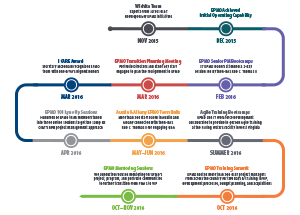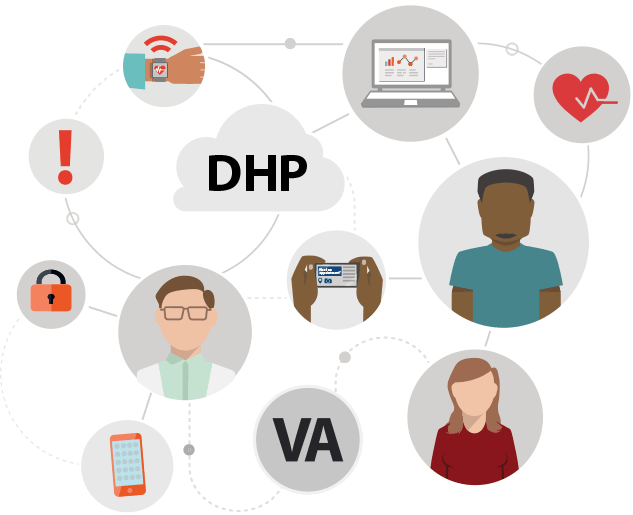A Year of Transformation - In Our Own Words
Where We Were
In 2015, the Office of Information & Technology was at a crossroads. The rapid expansion of information technology in our modern world created paradigm shifts in how individuals, commercial entities, academia, non-profits, and governments interact, and the pace of change and tectonic shifts in the global economy found VA's Office of Information and Technology (OI&T) wholly unprepared to meet the changing needs of its business partners and the Veterans we serve.
"People say, 'with government, it's going to be slow, you can't make change, things take forever.' And I say 'really, why is that?' The reality is, is that truth, or is that a vision we've walked into?"
The Honorable Ms. LaVerne H. Council October 15, 2015, GITEC

It wasn't always this way. VA has long driven advances in technology and delivered innovative solutions for our Veterans. Over the years, VA researchers nationwide have worked on thousands of studies to advance medical science treatment and technology. The list of accomplishments includes the implantable cardiac pacemaker, computerized axial tomography (CAT) scans, functional electrical stimulation systems that allow patients to move paralyzed limbs, the nicotine patch, and the first electronic ankle-foot prosthesis.
In 2006, all of the Department of Veterans Affairs' (VA) information technology functions were centralized into a single organization. Prior Chief Information Officers (CIOs) had direct influence over only 3 percent of the technology budget, and only 6 percent of the information technology professionals. Our IT team, policies, and operations were sprawled throughout a large network of medical centers, regional offices, and other facilities with no unifying team. Our IT systems were disjointed—we could not share business partner information nationwide, manage enterprise infrastructure, or ensure the security of our systems. VA had thousands of unsecured devices, a situation driven home in 2006 when 26 million Veterans' personal information was compromised.
But most of our attention went to the budget and system security. Over the past 10 years, the accumulation of burdensome, disconnected governance boards, and numerous artifacts and software development decision points stunted our ability to innovate—to engage our business partners in developing IT solutions that aligned with their strategic needs and create capabilities that delivered real value to the Veteran.
Our siloes of data throughout VA prevented clinicians from accessing a holistic picture of a Veteran’s service record. Our skilled developers and technicians around the country worked in vacuums, on projects that did not always align the technical solution to the needs of the Veterans we serve…and in ways that disconnected them from one another and from the heart of our mission, the Veteran.
Employees expressed frustration at the perception that there was a field-based OI&T and a "Washington OI&T." Requirements in the field were not always relayed to decision makers at headquarters. OI&T developed IT solutions that met the needs of a few without knowing what our business partners and field staff really needed from that technology. Our sequential, "waterfall" approach to software development resulted in cumbersome processes, lengthy delivery times, and prevented us from gathering meaningful requirements and iterative feedback from our business partners—the end users who relied on our IT solutions to address critical Veteran needs.
OI&T has 8,000 government employees and 8,000 contractors, and supports more than 1,600 VA facilities and 365 data centers, yet we had no single way of communicating with one another. Employees in the field did not know what was happening across OI&T, and there was no single voice telling the story of OI&T's successes … or single ear listening to the concern of our employees. We had a strategy disconnected from the needs of our employees, our business partners, and the Veterans we serve.
The outside world noticed.
Several high-profile media reports over recent years also highlighted how the build-up of bureaucracy over time had impacted care and services for our Veterans.
We were the subject of study upon study, assessment upon assessment.
Hundreds of findings, hearings, and interviews indicated everything that was wrong with OI&T … but very little acknowledgement of what was right.
A 2015 report from VA's Office of the Inspector General that examined OI&T's information security posture found that "Weaknesses in access and configuration management controls resulted from VA not fully implementing security control standards…[and] had not effectively implemented procedures to identify and remedy system security vulnerabilities on network devices, database, and server platforms VA-wide."
In July 2015, a self-assessment of our current state—which drew on employee interviews, external reviews, and meetings with oversight bodies—revealed significant internal challenges. The assessment presented a straightforward analysis of the challenges this office faced. It was also an opportunity to reimagine our place at VA, to envision an IT organization that fundamentally changed the way our Veterans interface with VA—and empower our business partners to provide industry-leading access, care, services, and benefits our Veterans have earned.
See page 7 in the Year End Review
Where We Wanted to Go
With the multitude of evaluations, opinions, and studies already at our backs, we entered the first quarter of FY16 knowing where we stood with the outside world, unsure of where we wanted to go next, but with a new Chief Information Officer (CIO) leading our team.
We were on a new clock, driven not by project milestones or a multi-year strategic roadmap, but one that would tick down to January 20, 2017: Inauguration Day for a new administration, and the likely last day of VA's Senate-confirmed CIO. OI&T had not yet figured out exactly what the MyVA initiative meant to our organization.
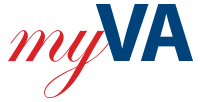
To achieve customer-service excellence across VA, we’ve been relying on five strategies. On July 22, 2014, Secretary McDonald promised Congress, all Veterans, and all Americans that, if confirmed, he would "renew the Department’s Strategic Plan and ensure it is properly deployed." That commitment helped define our five MyVA Transformation Strategies.
- Improving the Veteran experience.
- Improving the employee experience.
- Achieving support services excellence.
- Establishing a culture of continuous performance improvement.
- Enhancing strategic partnerships.
These strategies were shaped by the advice of the President, members of Congress, thousands of Veterans, leaders of our Veterans Service Organizations, our employees, and many other stakeholders. We were listening.
From the November 2016 MyVA Plan Update
We needed to harness the momentum the VA-wide transformation offered. We needed to change. We needed to adapt. We needed to become the world-class technology organization our partners required and our Veterans deserved. We needed to accept the opportunity our new leadership offered. We needed to become a cutting-edge force. We needed to become a team.
No longer could "in the best interest of the Veteran" be an email signature. With service at our core and Veteran teammates at our left and right, we would learn to weave the Veteran's needs, patterns, and desires into every aspect of our organization.
We began not with tasks, but with heart. We refocused not only on why we served, but how. OI&T's DNA is composed of four key principles: transparency, accountability, innovation, and teamwork.
We started asking difficult questions and taking the time to tell our story. We invited our business partners along for the ride, letting them see what—and who—it takes to make an IT organization successful. Listening to their opinions. We started to tell it like it is, not qualify or gloss over the truth.
We own the issues within our environment and our organization, and we hold ourselves accountable to take steps to improve them…and transparently share our progress along the way.
We committed to ask "why not" and "what if," to look at our environment and our Veterans' needs, and to find the opportunities to change things for the better. We would become experts in understanding what our partners need…possibly even before they realize their own need.
We now work for the success of the team, not the glory of the moment. Like any great team on the field, the court, or the track, we play our positions and manage our playbook. We focus on outcomes. Our neighbors' strengths are our opportunities—and our chance to build a stronger foundation to support our Veterans.
We began to evaluate every activity with outcome in mind, measuring the worth of our time not only through metrics, but whether or not it was in the best interest of our Veterans.
This landscape provided the perfect setting for VA's new IT Enterprise Strategy. From its very beginning, this strategy was unlike any other established within OI&T.
Our strategy is different.
What is different about the IT Enterprise Strategy?
The studies had already been performed. The data existed. The challenges and opportunities were known. All that was needed was a framework and plan to right the course.
And so the IT Enterprise Strategy was written by the CIO and validated by a small group of OI&T leaders over the course of three weeks.
This strategy is different because it is not based on high-cost studies or lengthy interviews. It is the result of common threads of fact from the 10 years since OI&T became a centralized office. It includes direct ties to our business partners' own guiding strategies. And it is influenced heavily by OI&T employee feedback.
Our mission and vision changed. They became simpler, more streamlined, sharper.
Old Mission
To provide and protect information necessary to enable excellence through client and customer serviceNew Mission
Collaborate with our business partners to create the best experience for all VeteransOld Vision
To become a world-class organization and industry leader in the delivery of IT products and services, information security and innovation to provide VA staff with cutting-edge tools needed to provide the best customer servicepossible to our VeteransNew Vision
Become a world-class organization that provides a seamless, unified Veteran experience through the delivery of state-of-the-art technologyIt is based in three simple time phases: Now, Near, and Future. All work within OI&T maps to these timeframes. The Now (0–6 months) allows OI&T to achieve maximum impact in the short term through quick wins. Near (6–18 months) takes steps to build upon those victories and carry our team's achievements beyond a single year. And Future (18–36 months) establishes an aspirational—but achievable—vision for each of the major areas within our organization.
This strategy is different because three key goals drive everything we do:
- Stabilize and streamline core processes and platforms
- Eliminate material weaknesses
- Institutionalize new capabilities to drive improved outcomes
These three goals were borne from the outcomes already mandated, those in progress, and those we knew we needed…but then extended to include dedicated activities to take care of our employees as well as the things we wanted to do to become a healthy and innovative organization. These three themes are lasting and enduring: not only did they guide our initial year of transformation, but they already frame our plans for 2017 and beyond.
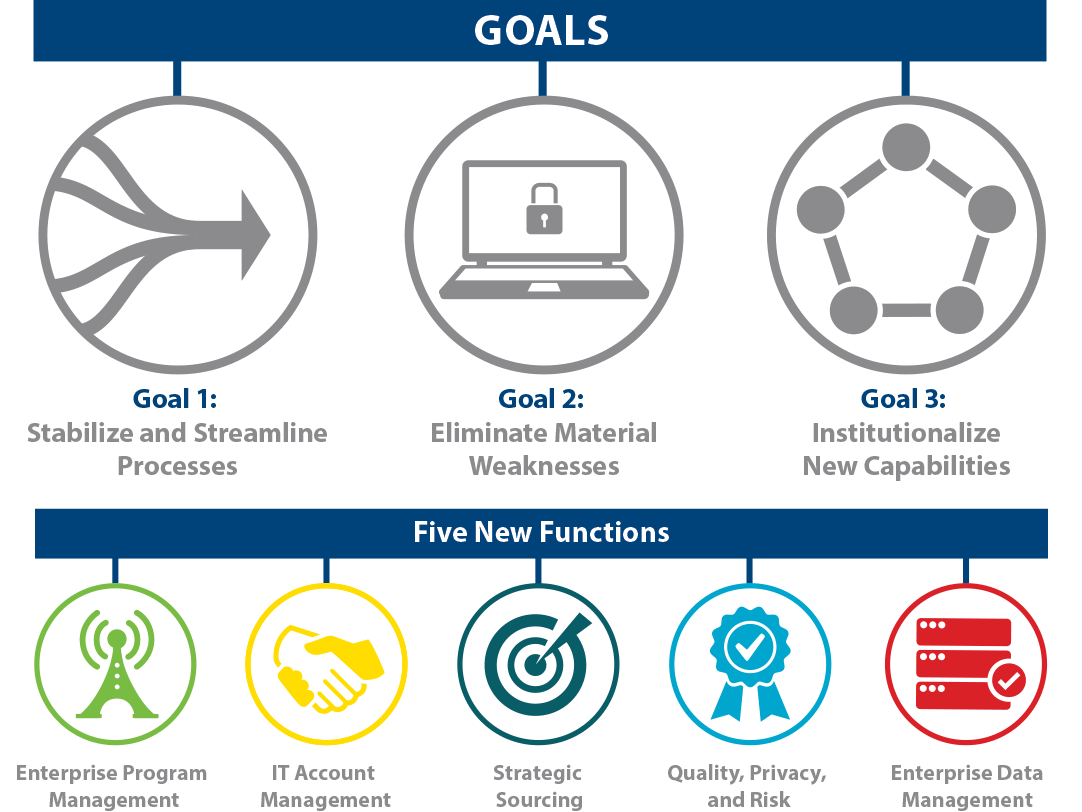
What else is different about this strategy?
It is practical. While it provides a roadmap for years to come, its structure outlines the initial and intermediate steps on that roadmap. It is immediately usable and constantly measurable.
The inaugural year of the IT Enterprise Strategy established five new functions, each tied to the three key themes and their own unique quick wins:
Enterprise Program Management Office (EPMO). OI&T's new control tower for IT development, EPMO, provides an enterprise-wide view of all ongoing projects, actively manages cyber risks associated with those projects, and ties project performance to outcomes that directly improve the Veteran experience.
IT Account Management. Three Account Managers partner with National Cemetery Administration, Veterans Benefits Administration, Veterans Health Administration, and our corporate functions to build technology aligned to our business partners' needs. In addition, the Enterprise portfolio Account Manager ensures that the interests and needs of OI&T itself are addressed and managed to propel the organization forward in a healthy, clear way.
Strategic Sourcing. OI&T now leverages the best of both our VA staff's expertise as well as the innovation of our external partners to deliver the absolute best solutions to our Veterans. Strategic Sourcing will improve our speed to market, ensure our compliance with IT acquisition legislation, and foster the most responsible allocation of taxpayer resources.
Quality, Privacy, and Risk (QPR). OI&T measures what matters, partners with oversight bodies, and links input to outcomes. QPR leads OI&T's performance management, process improvement, and oversight efforts in the areas of quality, risk management, organization development, and compliance.
Enterprise Data Management. Enterprise Data Management focuses on the collection, protection, and analysis of VA's wealth of data to predict patient needs, deliver specific outcomes, and share information across VA to improve the Veteran experience.
The IT Enterprise Strategy is ours. All Employee Surveys, the Federal Employee Viewpoint Survey, interviews with staff members—all were primary sources. And within four weeks of the strategy's introduction, OI&T's senior leadership team visited locations to share the IT Enterprise Strategy with OI&T's employees. These were conversations between team members and leaders — opportunities for every team member to find their place on the new road map.
What is different about this strategy?
WE ARE.
See page 11 in the Year End Review
How We Got There
Transforming the Way We Managed IT
With less than 18 months and the knowledge that we were driving toward expansive change, we looked at every aspect of the enterprise. From redesigning our IT development approach, to stabilizing and streamlining our core processes and platforms, to establishing clearer oversight, to taking an ever-more-strategic approach to planning for what comes next — we adjusted, we transformed, and we delivered.
The Hon. LaVerne Council
Rob C. Thomas II
Kai Miller
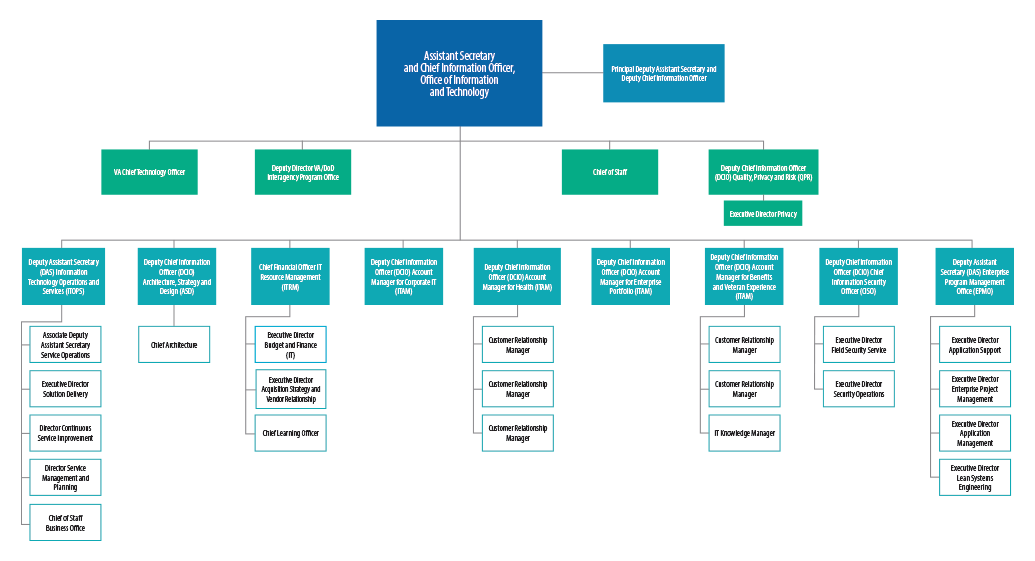 link to image of the new organization chart. See pdf for textual information.
link to image of the new organization chart. See pdf for textual information.
Redesigning OI&T Toward IT Service Management
We began with our development projects. OI&T has more than 300 formal IT projects—they are the backbone to VA’s health and benefits delivery capabilities. Paired with our nationwide IT operations systems, historically these projects are the primary way we provide value to our business partners, and they enable VA to deliver care and benefits to Veterans safely, securely, accurately, and on time. These projects are part of how we serve our Veterans. In November 2015, a group of experts from across OI&T, led by Deputy Assistant Secretary Rob C. Thomas II, took the first of many steps towards transformation. Mr. Thomas’ team—which became known as the Wichita Team—began their work by closely examining every step in OI&T’s process to develop key functionality and streamline and revolutionize processes across the enterprise.
For the first time, we had a highly predictable workflow for all of our operations. We took the unknown out of our everyday processes, which led to better coordination across our divisions and more efficient delivery of IT services to our Veterans. When fully realized in OI&T, our offices, leaders, and staff will have more clearly defined roles and processes to follow when conceiving, developing, and delivering IT solutions.
Transforming Service Deliver and Engineering (SDE) into Information Technology Operations and Services (ITOPS) moved us closer to realizing our IT Service Management goal. Achieving this goal places OI&T among some of the industry’s best IT organizations. To get there, we needed every member of the team to understand the playbook. So we worked with industry leaders and leveraged the Information Technology Infrastructure Library (ITIL) framework.
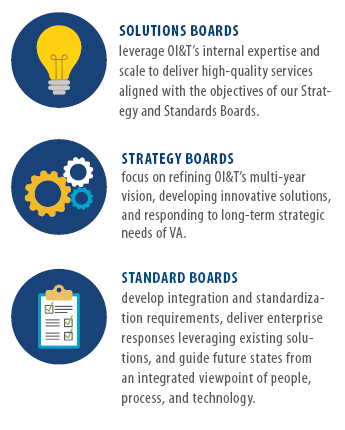
ITIL provides a set of IT practices we can apply to our organization to help us collectively define the work that we do. Simply put, ITIL gives us tools that, when integrated into our strategy and processes, put us on all the same page with regard to the work we do and how we do it. ITIL makes sure we all speak the same language by achieving concurrence on the terms we use to describe our work—so that when anyone in OI&T uses a term like "Capacity Management" or "Portfolio," others know exactly what we mean. Unlike legacy OI&T processes that were valuable steps in our current journey forward, ITIL is an industry best practice used by private and public IT organizations throughout the world to manage IT delivery, drive down costs, and maximize value. ITIL is proven to work.
Our momentum will not be shaken. To sustain our transformation, we are using the ITIL framework and have established an OI&T-specific governance structure that complemented industry standards and was tailored to our mission and vision. Our governance structure helps us align our IT goals and strategy to the tactical work we do, identify and mitigate risks, and improve compliance with oversight authorities. As of October 1, 2016, OI&T has 11 Governance Boards in three categories: Strategy Boards, Solutions Boards, and Standard Boards.
Establishing EPMO
In April 2016, OI&T created the Enterprise Program Management Office (EPMO), the "control tower" for major OI&T initiatives. EPMO provides a portfolio-centric approach to project management, valuing people over processes and delivering improved outcomes to Veterans.
On September 30 we reached a huge milestone. EPMO reached Full Operational Capability, successfully transitioning over 200 projects from the former Project Management Accountability System (PMAS) into Veteran focused Integration Process (VIP). VIP provides an agile, streamlined approach to project management, including a single release process, fewer required artifacts, and a shorter delivery cycle. VIP uses a single release process to eliminate redundancy in review, approval, and communications. VIP is revolutionary.
We are winning project management with VIP
Our transition from PMAS to VIP has already improved how we deliver IT to VA...

Our new VIP Dashboard (released in October) allows ourselves and our customers greater visbility into project progress and success.
Quality, Privacy, and Risk
Recognizing that our "control tower" and IT Service Management foundation was only as strong as our accountability, risk management, and governance efforts, we established our Quality, Privacy, and Risk (QPR) function.
To begin, QPR leadership identified four key focus areas:
- Organization standup targeted structure, key positions, and assets;
- Strategic foundation provided a roadmap for governance needs and structure;
- Quality review and improvement developed methods to assess and track material weaknesses; and
- Oversight commitments established tracking and reporting, and implemented audit recommendations for material weaknesses.
By focusing on these areas, we instilled a greater sense of responsibility across the organization, placing accountability for the outcomes of our work on the very individuals performing the work and making the decisions, instead of deferring accountability to the QPR office itself.
Our QPR efforts expand the mission of our legacy quality and compliance efforts and fosters a more transparent OI&T. Now, we can actively engage and collaborate with all offices in OI&T to ensure enterprise-wide compliance with all regulations and directives. We all share accountability.
Steven Schliesman
Sean Kelley
See page 25 in the Year End Review
Transforming to Provide the Services our Veterans Need
Look at the world in 2016. We communicate and coordinate via smartphones and tablets. We create and capture an unthinkable amount of information every day. We store information in the cloud. Technological solutions emerge daily to solve almost every problem.
Our Veterans need the same seamless relationship with VA technology that they have with their iPhones, laptops, and wearable devices.
We realized that when we provide cutting-edge, efficient IT organization and tools to our staff, Veterans become empowered by a cutting-edge, efficient VA.
We streamlined our approach so we can more easily advantage of emerging technology and industry best practices to modernize VA and the Veteran experience. These key service delivery accomplishments represent a new foundation for the IT services that keep VA running—all day, every day—and lay the groundwork for continued transformation toward a Veteran-centric future. We moved toward an even greater service delivery future.
To initiate transformation from a service delivery perspective, OI&T deployed a nationwide evaluation and analysis of its operations, sending leaders and staff to multiple sites to witness OI&T’s work in person, and conducted more than 100 interviews with OI&T staff and our customers. We met with professionals at companies like Dell and at other federal agencies like U.S. Immigration and Customs Enforcement to discover best practices we could bring to VA to change our business for the better.
The results of our analysis led us to develop five key transformational efforts in service delivery that we either began or completed in 2016 (results are described throughout in this section). But our deep dive look at our business netted these additional results:
- We started co-locating IT staff within facilities to increase collaboration opportunities. In our evaluation, we found offices where IT support staff serving VBA and VHA were located on separate floors of the same building, isolated and sometimes unaware of each other.
- We started to improve IT support so that remote employees can now resolve IT issues at whichever VA facility is closest to them—instead of having to visit the location to which they report.
- We sought participation from employee labor unions as part of our transformation plans to ensure that our changes are made with the employee in mind.
Gary Marshall
Scott Blackburn
See page 33 in the Year End Review
Transforming VA Cybersecurity
Protecting Veteran and VA employee information is one of the most important jobs entrusted to OI&T. However, Cyber threats present us with changing and increasing demands and hackers are getting smarter and savvier. We recognized that, as an IT organization, we needed to get smarter and savvier when it came to protecting data.
During our transformation efforts, we demonstrated our steadfast commitment to protect our Veterans' personal information by establishing an Enterprise Cybersecurity Strategy and building a team to execute our new strategy. In addition, we adjusted our cybersecurity approach to fully integrate information protection into our future service managed environment and laid the foundation for security integration in everything we do.
In fact, in analyzing our organization, we realized that our successful transformation into service management depends on successfully integrating security into everything we do, from high-level governance and strategic planning to the field, where the vast amount of information we protect is used every day in service to our Veterans. And while we knew that protecting data, especially electronic data, was not going to be easy— we rose to the challenge.
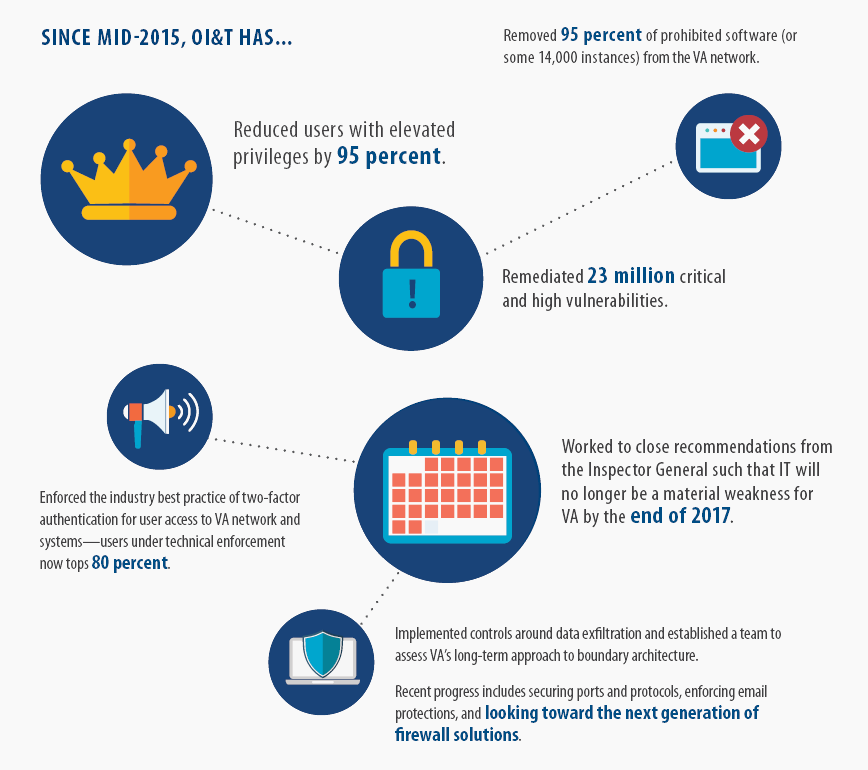
Roopangi Kadakia
Dominic Cussatt
See page 38 in the Year End Review
Transforming Our Relationships
As large and talented as we may be, OI&T cannot do our job alone. We need our partners and our customers - and just like any other large organization our success depends on the working relationships we maintain with our customers and partners.
Throughout our organizational analysis, we found that some of our relationships were not receiving the attention they deserved and that we needed to do a better job of proactively engaging with all our partners. We realized that if we nurtured more industry partnerships, we could innovate the Veteran experience further and faster. And we decided to take a more strategic approach to accessing support from contracted suppliers. We wanted to deliver value.
VA is a vast and complex enterprise. It takes thousands of people to support the technology that enables and empowers the enterprise. And we need to engage each and everyone one of them—VA employees, outside partners, and our customers. Ultimately, ours is a story of teamwork.
Account Management
Our new Account Management Office (AMO) provides the critical link between OI&T and our business partners so that we deliver software and services that meet their current needs and remain flexible to change with the future needs of Veterans. AMO fundamentally changes the way we approach serving our business partners. Instead of playing the role of "service provider" to VA, we established ourselves as VA’s strategic partner in IT.
To properly build these relationships, we first defined three balanced portfolios that represented the full scope of services VA provides to the Veteran. Then we appointed four IT Account Managers (ITAMs) to collaborate with the business partners within each portfolio:- Account Manager for Health: manages the Homelessness and Access accounts
- Account Manager for Benefits and Veteran Experience: manages the Care in Community, Compensation and Pensions, Contact Centers, Veterans Crisis Line, and Unified Veterans Experience accounts, as well as the Improve Veterans Experience and OI&T Transformation accounts
- Account Manager for Corporate IT: manages the Supply Chain, Appeals, Staffing, and Leaders Developing Leaders accounts
- Account Manager for the Enterprise Portfolio: manages the IT Infrastructure and Enterprise Services accounts
Our Account Managers are far more than liaisons. They are the senior executives who represent the CIO to our business partners. They carry decision-making capability, but they are bilateral experts in both technology and business partner needs. They meet regularly with the leaders in charge of delivering care and benefits to Veterans, discussing and assessing their needs and the support we provide.
Strategic Sourcing
Since centralization, OI&T staff provided valuable input in acquiring the best solutions for VA and Veterans, but OI&T itself did not have a strong enough voice in technology acquisitions conversations. The results were disconnected technology acquisitions, redundant solutions, suppliers of mixed quality with little-to-no lifecycle accountability, and spiraling costs.
Today, we have implemented a Strategic Sourcing function to leverage decades of experience and become trusted partners in all technology acquisitions decisions.
Strategic Sourcing consolidates OI&T’s purchasing power into a Strategic Sourcing Office dedicated to obtaining the best solutions from the best industry talent at the best price. Our acquisitions staff will be subject matter experts on IT acquisitions VA-wide, thanks to increased acquisitions authority. A more streamlined, OI&T-based technology acquisitions process means better solutions more quickly, with less overhead. After contract awards, suppliers remain accountable for their performance through continuous monitoring of the sourcing lifecycle, resulting in reduced Total Cost of Ownership for VA.
Strategic Sourcing allows OI&T to:
- Maximize value by optimizing the stewardship of tax dollars.
- Improve supplier-delivered product/service quality.
- Better leverage supplier expertise and industry knowledge.
Strategic Sourcing doesn’t just empower acquisitions staff. All will have access to best-in-class suppliers, continuous monitoring tools to ensure contractual performance remains strong throughout the lifecycle, improved speed-to-market, product compliance and quality, and greater technical capabilities to deliver to VA and Veterans.
Tracie Loving
Alan Constantian
See page 46 in the Year End Report
Transforming the Veteran Experience through Innovation
Over the past year, OI&T transformed service delivery, streamlined processes, and built new partnerships with stakeholders keeping the Veteran experience in mind as a central focus. In 2016, innovation through partnership and collaboration resulted in the development of applications such as the Care Now App that provides Veterans access to mental health practitioners and appointments via "FaceTime" on a Veteran’s cell phone. And the Annie App, a text messaging app for VA patients to promote self-care.
In 2017, OI&T will continue to eliminate material weaknesses, streamline its core processes, and develop capabilities that drive improved outcomes. Veterans will access even more innovative technologies, suited to their needs, and quickly delivered. When Veterans interface with VA, their information will be consolidated and accessible. The proper collection, protection, and analysis of Veteran data leads to analytics-driven innovation. These innovative efforts reinvent the way our Veterans interact, through technology, with VA. We are delivering an entirely new Veteran experience.
Digital Health Platform
VA's award-winning electronic health record, VistA, established VA's position as a health technology innovator 40 years ago. However, yesterday's technology does not support the changing demographics of today's Veteran. The number of women Veterans has and will continue to grow, the Vietnam Veteran population is now over 65 and the need for specialized care (e.g., prosthetics) has only increased. In addition, the prevalence of many common chronic conditions is projected to increase among Veterans over the next 10 years. Supporting these health care needs requires adoption of newer models of care consistently across the organization.
Recognizing changing Veteran needs and the unsustainable cost of maintaining more than 130 instances of VistA, VA senior leaders agreed that our current model is unsustainable and limits agility and functionality to both clinicians and Veterans.
To address this concern, OI&T partnered with VHA to develop the foundation for a new health care delivery model—the Digital Health Platform (DHP). In September and October, we validated DHP through two proofs of concept and in December, we finalized our business case and acquisition strategy for the build and implementation of DHP.
We demonstrated that this model will work. With the right partners and with collaboration inside and outside VA, we now know we can develop the best health platform for our Veterans.
Interoperability
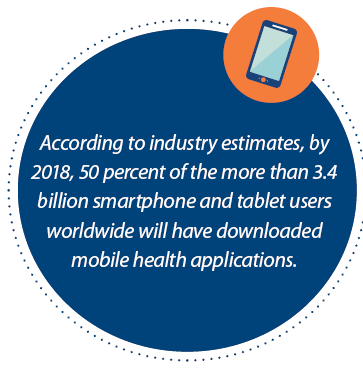 Access to accurate Veteran information is one of our core responsibilities. We recognize that a Veteran’s complete health history is critical to providing seamless, high-quality, integrated care and benefits. Interoperability is the foundation of this capability, as it enables clinicians to provide Veterans with the most effective care and makes relevant clinical data available at the point of care.
Access to accurate Veteran information is one of our core responsibilities. We recognize that a Veteran’s complete health history is critical to providing seamless, high-quality, integrated care and benefits. Interoperability is the foundation of this capability, as it enables clinicians to provide Veterans with the most effective care and makes relevant clinical data available at the point of care.
VistA Evolution is the joint VHA and OI&T program for improving the efficiency and quality of Veterans’ health care by modernizing VA’s health information systems, increasing data interoperability with the Department of Defense (DoD) and network care partners, and reducing the time it takes to deploy new health information management capabilities. For front-line health care teams, the two most exciting products from VistA Evolution are the Joint Legacy Viewer (JLV) and the Enterprise Health Management Platform (eHMP).
Joint Legacy Viewer
The Joint Legacy Viewer (JLV) is a clinical application that provides an integrated, chronological display of health data from VA and DoD providers in a common data viewer. VA and DoD clinicians can use JLV to access the health records of Veterans and active-duty and Reserve service members on demand.
JLV enables health care and benefits professionals to see VA and DoD health care data on a single screen, improving availability of health care information, efficiency, and overall ability to deliver high-quality care.
We are proud of the advances in interoperability that JLV has provided, but they are part of a larger journey. Interoperability goes beyond sharing information with DoD; to improve health outcomes for Veterans, it must include information-sharing with private-sector providers, improve movement of data between VA facilities, and include more than just health data.
- 203,785 Authorized VA health care users
- 14,274 Authorized VA benefits professional users
- 2,000,000+ Records Accessed
*Data as of December 11, 2016
The need for more agility in the way VA delivers health care has never been greater. With the expansion of care in the community, a rapidly growing number of female Veterans, and increased specialty care needs, Veterans need an integrated, fully interoperable, continuously learning solution. Though VistA has served our Veterans well over the past 40 years, and even as we continue to add functionality through tools such as JLV, we are looking beyond current modernization efforts and are further developing the Digital Health Platform. Our Veterans need and deserve this.
Ron Thompson
Linda Ennis
John Short
See page 52 in the Year End Review
Transforming Employee Engagement & Development
Our OI&T transformation is a story about people—not software, not hardware, not strategies, not plans. People achieved our many successes in 2016, and people will continue to innovate, achieve, and transform OI&T in 2017 and beyond. People are at the heart of our organization.
We learned this year that we need to listen to and communicate with people across VA. Through surveys, nationwide town hall meetings, and in conversations with OI&T employees and our customers, people told us that communication could be better. We heard them, and we took action.
So in March 2016, we formed a task force to engage with employees to find out what people need and want from leadership and to discover what was missing in OI&T that could help employees in their jobs. That task force is now formalized in OI&T as the Office of Organization Development & Engagement (OD&E) — dedicated to everlasting exchange of ideas and information with leadership to continually improve employee satisfaction, engagement, development, and reward.
Make Your Voice Heard
In April, we created a feedback loop called "Make Your Voice Heard" to promote bi-directional communication between subject matter experts and employees. Available to all OI&T employees, the platform provides employees with official responses to questions about Human Resources, IT Support, Travel and Training, Budget, Product Delivery, and many other topics. We received more than 180 questions in the span of seven months.
Employee Development

After hearing employees’ desires for increased access to training and learning opportunities, we delivered new learning solutions to address employee skill gaps and needs. These new learning opportunities are directly aligned to OI&T Transformation goals and objectives and include training in Agile project management, VIP, and ITIL.
Additionally, we designed a cohort of competency-based training models that align with OI&T’s critical transformation objectives. The models address areas like cybersecurity, customer service, and Veteran Service Motivation and will promote employee proficiency in skill areas essential for OI&T’s transformation, provide clear career paths for employees to develop increasingly complex skills, and will result in better service to our business partners and Veterans.
To continue to drive a culture of leadership within OI&T, we embraced the Leaders Developing Leaders (LDL) program, a training curriculum that helps individuals at all levels lead and facilitate organizational change. It emphasizes VA’s culture, processes, capabilities, and leadership development through "servant leaders" who foster continuous engagement, strategic thinking, and change management. The effort has reached 85 percent of OI&T employees. Participants reported a 60- to 80-percent positive increase in Transformation awareness, feeling that they are valued as employees, and are witnessing positive change.
Nicole Gilbride
Nicole Mayerhauser
See page 61 in the Year End Review
We are Veterans.
We are the American public.
We are leaders.
We are innovative.
We are accountable.
We are teammates.
We are OI&T.



